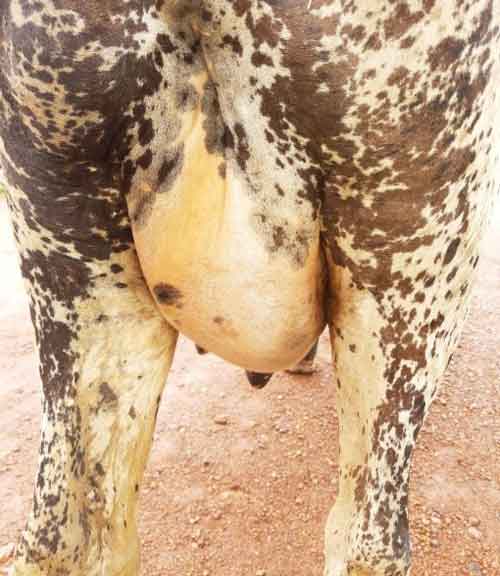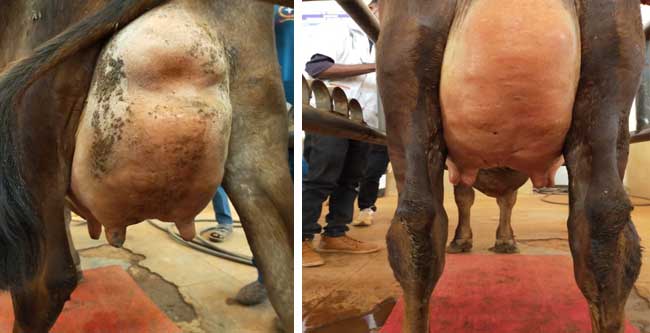Udder edema is also known as caked udder, is mostly a disease of dairy cattle, is usually acute characterised by an excessive accumulation of fluid in the interstitial tissue spaces.
Occurrence
Udder edema usually occurs at the time of parturition ,sometimes developing to a serious degree before parturition occurs (Joshi et al.1978; ahmad 1978; sinha et al. 1981) It affects first calf heifers as well as old cows, with animals of higher production potential.
Economic importance
Udder edema might cause losses in dairy cattle as decrease in milk production because of the pain. Edema can lead to permanent damage to udder ligaments and tissue. Subsequent attacks of udder oedema may result in scleroderma.
Predisposing causes
Age at first calving ,gestational length, genetics, nutritional management , obesity and lack of exercise during precalving period.
Causes
Exact cause of udder oedema is unknown. However, udder edema at parturition results from a decreased mammary blood flow associated with an increase in the venous blood pressure in the cranial superficial epigastric veins.
- Hereditary trait in some cows
- Mammary blood and lymph flow: increasing pressure caused by fetal growth results in restriction of blood and lymph flow away from udder in late pregnancy (at least 3 fold increase in mammary blood flow from two weeks before parturition to parturition, cows with udder edema had a 17.1% lower mammary blood flow than cows without udder edema at parturition). It’s a factor in the development of udder edema at calving. Increased lymph formation due to increased metabolism of tissue may result in an inability of lymph vessels to remove all lymph. Stasis of milk in the udder, commonly observed in heifers due to failure of milk letdown (Gouge et al.1959)
- Feeding: increased green feeding will increase the incidence of udder edema. High intake of potassium during dry period predisposes cows to udder edema by increasing fluid retention.
- Salt intake: increased edema occurred in heifers supplemented with sodium chloride but no effect on cows.
- Hormones: plasma oestrogens and progesterone had a significant association with mammary edema during prepartum period. Oestrone and oesterdiol-17 alpha may promote increase in severity of pre-partum edema whereas progesterone antagonizes.
- Plasma proteins: cause of udder edema is decreased osmotic pressure near parturition (Larson and hays 1958).
Clinical signs
Two forms of udder edema recognized in cattle based on presence of clinical signs of udder edema near at parturition in the first and occurrence of udder edema during lactation in the second.
- Acute or physiological form
- Chronic or pathological form
Clinically it has 2 stages, during first stage there is a gradual congestion of skin of udder, udder greatly distended, swollen and filled with colostrum.During 2nd stage, digital pressure produces pitting of the oedematous areas, which last for several minutes and is characteristic.
Udder skin becomes thick and hard on digital palpation. In some cows several areas of separation skin which allows exudation of clear, straw coloured fluid.
Typical case involves all four quarters of udder, but may involve only one-half or even single quarter of udder (Marrow and Schmidt 1964)
Depending on severity of the condition, subcutaneous edema may extend from rear udder up to vulva and from the fore udder to umbilicus or, extreme cases, the brisket (AI-Ani & Vestweber 1985).
Edema scoring system
Degree of udder edema is frequently scored. Visual scores that range from 0 to 15 have been used (Schmidt & Schultz 1959; Hemken et al.1969; Carlsen et al. 1969 ;Beardsley et al.1974 ; Dentine 1982; AI-Ani 1984).However score from 1 to 5 commonly applied , in which 1 indicates no edema , score of 2 slight edema ,3 means moderate edema ,4 means severe edema and 5 means very severe edema (AI-Ani & Vestweber 1984 ab,1985; Dentine & McDaniel 1984)

Diagnosis
- Based on history of the condition, nature of enlargement, consistency of tissues involved and type of fluid present, clinical signs (symmetrical edema, pits on pressure, absence of heat &occurrence near parturition.
- Microbiological studies on milk sample will help to distinguish between udder edema and mastitis

Differencial diagnosis: Haematomas of udder, ventral abdominal hernia, mastitis.
Treatment:
- most cases does not need any treatment. The swelling decreases gradually after calving.
- 20 minute massage, three times daily together with the alternate application of hot and cold water, along with mild exercise will help to remove fluid in cows with poorly attached udder.
- Severe udder edema – milking should be started some days before parturition, after parturition frequent milking and diuretic agents recommended. Corticosteroids appear to exert no beneficial effect.
- Acetazolamide @ 1-2g twice daily orally or parentrally for 1-6days, gives excellent results in high proportion of cases, edema often disappearing within 24hrs.
- Chlorothiazide @ 2g twice daily orally or 0.5g twice daily by IM OR IV.
- Frusemide @1mg/kg body wt IM OR IV, 5mg/kg body wt orally in severe edema but prolonged use may result in hypokalemia, hypochloremia and metabolic alkalosis.
- Feed should be properly balanced for protein and energy, supplement antioxidants such as vitamin E and Zn which help to reduce effects of oxidative stress on udder.

Prevention and control:
- Condition is eliminated by selective breeding
- Good husbandry and management at parturition, including mild exercise, proper bedding, mild laxative diet and use of udder support and massage.
- Induction of parturition by the use of dexamethasone and oestradiol benzoate injections demonstrated a significant lowering of incidence of udder edema (Bolte 1975; Schmitt et al. 1975; Bolte et al.1977)
- Other management practices include controlling of hypomagnesaemia and decrease in potassium content of the ration may have some preventive effects.
References
- Research gate article- Udder edema –an updated review by Falah AI-Ani A’Sharqiyah University
- Veterinary medicine BLOOD 10TH
- Preventing udder edemas in dairy cows –Nutrition update volume 13No. 1 May 2002
- MSD Veterinary manual.
|
The content of the articles are accurate and true to the best of the author’s knowledge. It is not meant to substitute for diagnosis, prognosis, treatment, prescription, or formal and individualized advice from a veterinary medical professional. Animals exhibiting signs and symptoms of distress should be seen by a veterinarian immediately. |






Good information doctor 👍
Nice article doctre
Nice information…
All the best…